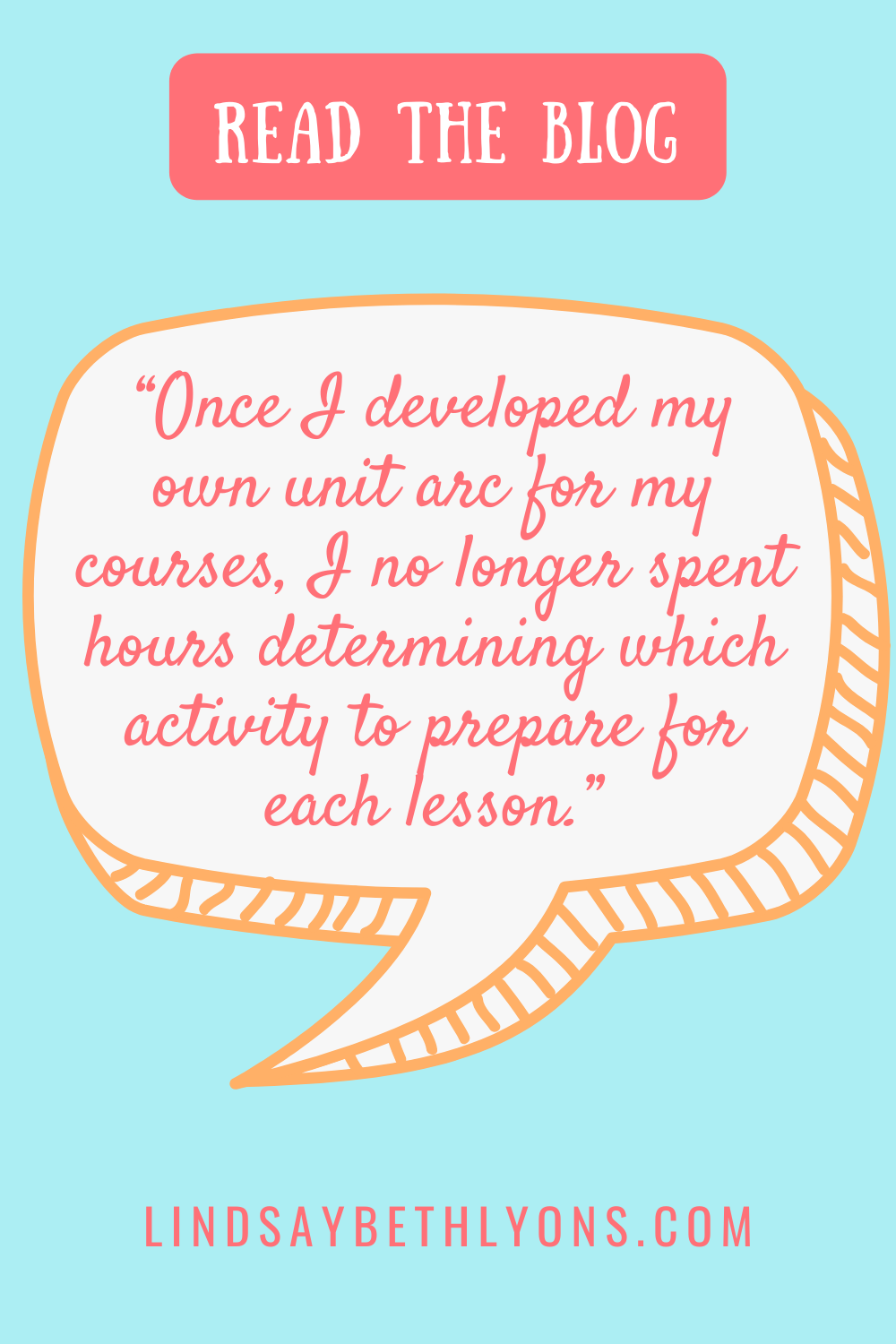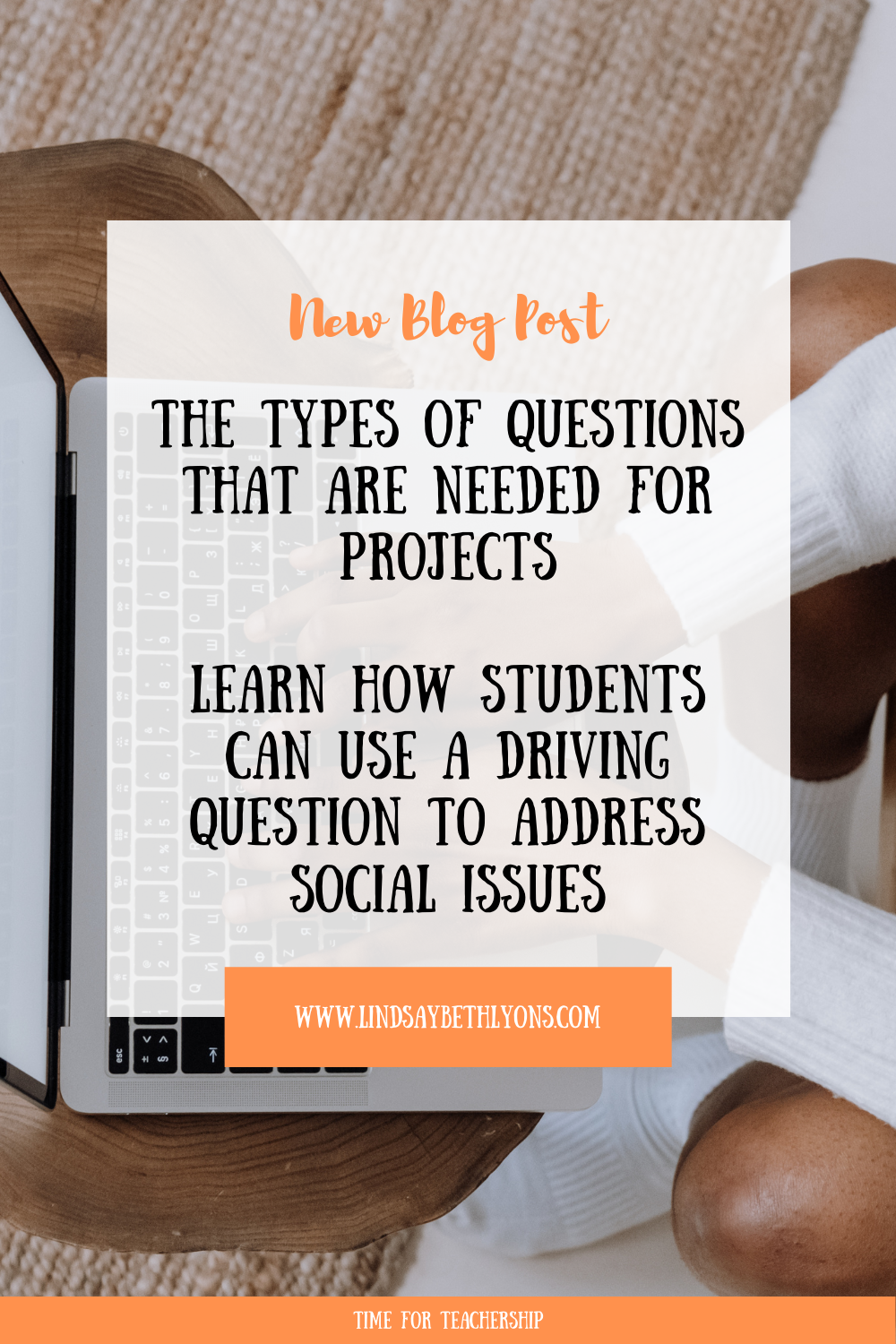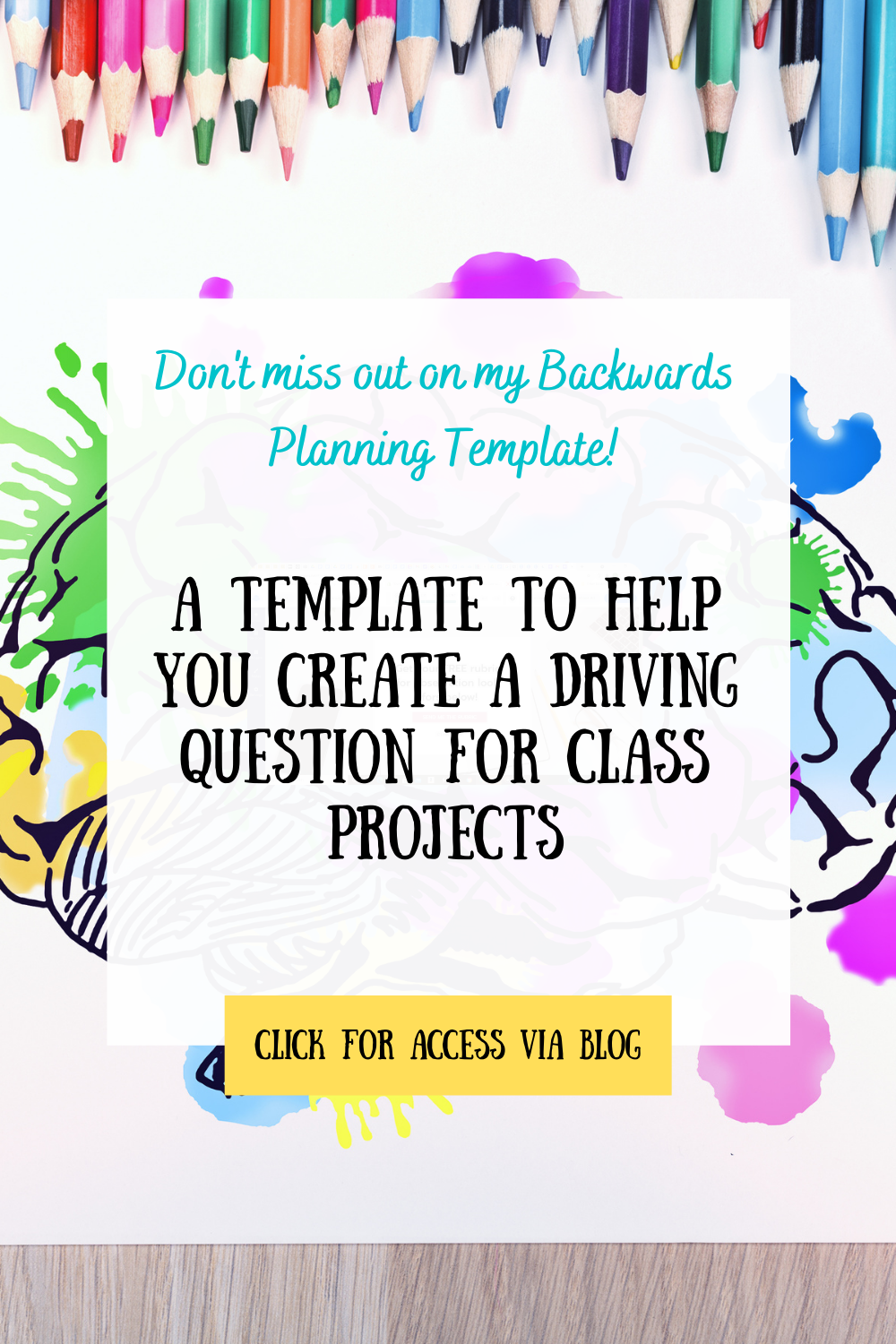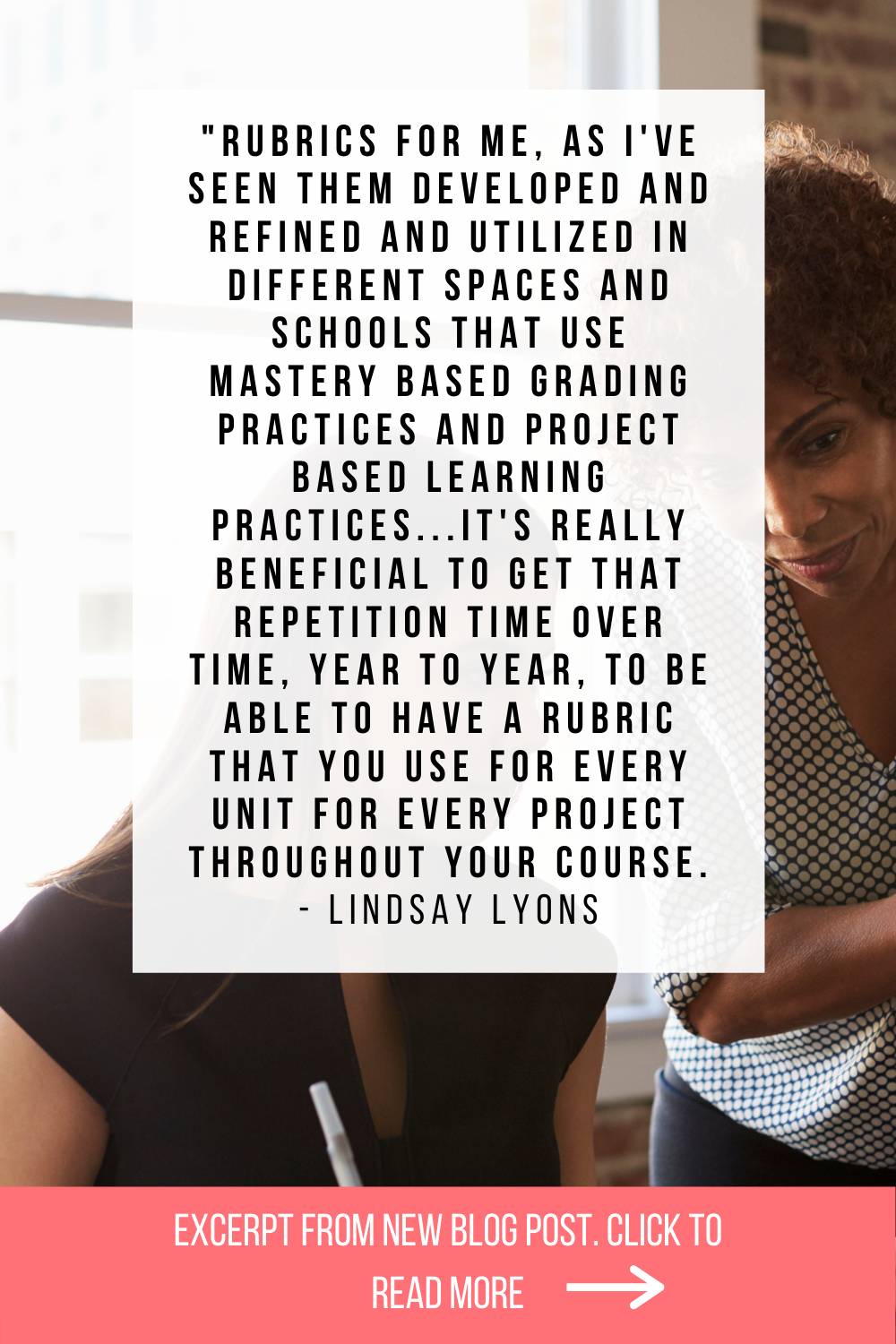|
Listen to the episode using the above player or by clicking the link to your preferred podcast platform below: Make it simple with a unit arc During my third year of teaching, I remember first hearing about unit arcs while sitting with my curriculum coach at the time. I was amazed at the possibility of using a handful of protocols again and again to save me so much time and energy as a teacher. As you’ll see, making your own unit arc doesn’t have to be scary. But it is a critical part of creating your own curriculum plans for your class. If you’re wondering what a unit arc is, it’s the pattern of purposeful learning experiences in which students engage throughout a unit. Establishing a pattern makes it predictable and simple for you to do each year. For a successful learning experience, make sure it is student-centered. The teacher should minimize their involvement while giving students the reins in solving challenges. Purposeful Protocols So what are the protocols that make up a unit arc? Behind each protocol should be a purpose. The four protocol purposes that I thought of after reading El Education’s protocols are as follows:
You definitely don’t have to come up with a hundred protocols. I recommend that you choose between 3 to 5 protocols using these 4 purposes. “Once I developed my own unit arc for my courses, I no longer spent hours determining which activity to prepare for each lesson.” Unit arc examples Unit arcs will vary from subject to subject, grade to grade, and teacher to teacher. Here’s one example of a unit arc used for a social studies class: First lesson—hook, Second lesson—establishing prior knowledge of students, Third lesson—broad overview, Fourth lesson—primary sources, Fifth—discussion, case studies, and so on. The type of unit arcs I create and help others make, focus on creating interest and engagement from students. These types of unit arcs provide students the chance to create meaningful work that tackles current issues in the present. I also believe that part of connecting students with these projects comes from allowing students to talk about these projects with an authentic audience. A great way to finish off a unit arc is with time for reflection. Students have the opportunity to consider what went well and get some helpful feedback on their work. Rarely do I find a bored student when using these unit arcs. The reason is that engaging content combats boredom. When students are engaged, they are building relationships with other students, staff, and faculty. They also take more ownership and improve communication skills and confidence. Battling boredom with engaging content is particularly if your classes are still being taught virtually. Trying to keep a student engaged while they’re watching you through a screen is challenging, and these unit arcs will make a world of difference. My suggestion for you now is to take the protocols that your students have already been loving and start building out that arc. To dive deeper into learning how to engage students, I have great news! You can register for my free 1 hour masterclass HERE or below. For more, check out my Curriculum Boot Camp course or the “Just the Protocols” module now so you can create your own project-based units grounded in justice in no time at all! Continue the conversation below in the comment section and join our community of educational visionaries on Instagram, LinkedIn, and Facebook. Until next time leaders, continue to think big, act brave, and be your best self.
0 Comments
Listen to the episode using the above player or by clicking the link to your preferred podcast platform below:
Driving questions, Essential questions, and Supporting questions This series, we’ve been talking a lot about project based learning. One of the main elements of Project Based Learning is coming up with a driving question. What’s a driving question? It is one that’s aligned with learning goals, engaging, allows for open ended responses, rooted in a specific context, clear, and centers justice. There are also essential questions and supportive questions. Grant Wiggins has a blog post that explains the difference between all of these. The essential question stays relevant and comes back into curriculum unit after unit, even moving between subjects and grade levels. Supporting questions are small scale. They have an agreed upon answer and they help students in answering their big driving question. All of these question types are helpful for different reasons. They all go together into completing a project that looks at an issue. What’s important here is not trying to leave any out or substitute one for the other. In this episode, we're diving into the details of a driving question. “There are different levels of questions and an essential question as the driving question for a project is not going to cut it. it's not going to be super engaging, it's not going to be contextualized in a way that makes sense for the project so students might be confused; they might just be disinterested. And the supporting or what I have been calling the scaffolding question is just way too narrow.” What make a driving question stand out? It’s important for a driving question to be exciting for students. If there’s no interest, it’s automatically going to be a less effective project with answers that may not be fully developed. We want it to be in a specific context so that it’s not too broad. It needs to be open ended so that students can all respond in their own way with something unique to bring to the table. It should be clear; students should know what is being asked of them. Lastly, it should center justice and give students a chance to be a part of real world problem solving. Examples A way to make sure that your driving question hits all of these elements is to create at least 5 rough drafts before you decide what your final question is. Additionally, ask a friend or students for feedback to see if anything’s missing. To borrow an example from John Larmer at PBL Works, if you were going to talk about math and basketball, your first draft might look something like this: How is math used in basketball statistics? Then it could progress to: Is Lebron James the best basketball player ever? There’s a clear difference here for a couple reasons. First, it’s gotten more specific. It is more compelling. People are much more interested in Lebron James as the subject. And it’s created another question about how to define best and what that’s based on. Now it would have to be edited further to include justice. Sometimes when justice is added to the question, the question may get bulkier or less clear, so you want to try to maintain a balance all of these qualities. Some of the possible directions you can go with driving questions is making it:
Here is John Larmer's post with some more sample questions to check out Closing activity: As we close this post, just take a moment to do some brainstorming. Think of a unit idea/topic that you could use for your question. Then try to come up with those 5 minimum drafts. Use the Backwards Planning Template to give you a checklist for driving questions as well as some other info you won’t want to miss. If you have any further questions feel free to reach out! For more, check out my Curriculum Boot Camp course or the “Just the Protocols” module now to create your own project-based units grounded in justice in no time at all! Until next time leaders, continue to think big, act brave, and be your best self.
Listen to the episode by clicking the link to your preferred podcast platform below:
One of the foundational elements of backwards planning justice-centered units with flexibility and multiple opportunities to practice skills is a course-long rubric. Getting clear on where we're going helps us as educators, and that clarity helps our students. Using one rubric for all course projects In last week’s post, I touched on project based units, curriculum design, equity, and mastery based grading which helps students deeply understand content and repeatedly practice and refine key skills by addressing one driving question throughout a unit. We cannot design application projects or create lesson-level activities for students to practice the key skills if we don't know what the key skills are. That's why a course-long rubric is step one. “Work within your department or the grade you teach to be able to co-create a rubric that has the same priority standards so that students moving class to class or grade to grade, year to year, they see the same language... and they get further opportunities to be able to practice and refine those skills.” Co-creating this rubric with fellow teachers who teach the same content or grade level will result in a better rubric that's aligned from year to year and class to class. It also saves the student the trouble of having to read through and learn new rubrics. Now, there are two ways you can make a rubric for mastery. One is called a single point rubric. The three columns are: Approaching standards, Outcome, and Above Standards. In the middle column, you will list all of your outcomes. So name the skill and under it explain what being proficient in that skill would mean. The other two columns are for you and a student to write your own notes. If a student is not quite at the standard, you will describe why in “Approaching Standards” and if they have gone above those standards you write how they exceed the standards in the “Above Standards” column The second option is a three or four point rubric with 3 or 4 vertical columns and horizontal rows for the priority skills. The difference is that you define each category of mastery on this rubric (e.g., below standards, meets standard, and above standard). Best practices:
I think you’ll find it useful to hear about the skills-based rubrics that the New York Performance Standards Consortium has developed. Many schools have adopted these standards and it’s great to see these collaborations between departments in different schools. Their four point rubric is based on these core subjects: ELA, Social Studies, Science, Math, and Engineering/Design Science. The priority skills listed for ELA are organization, analysis & interpretation, style & voice, connections, conventions (written) or presentation (verbal). Social Studies is viewpoint: thesis & claim, evidence & sources, analysis & persuasion, effective organization, understanding of implication & context voice, and a presentation format. For science they have the presentation piece plus contextualize, critique, experimental design, collect/curate/organize/present data, analyze & interpret results, revise original design. Math is problem solving, reasoning & proof, communication, connections, representation. Finally engineering/design science contains problem solving, reasoning & proof, communication, connections, representation and a presentation format. Rubric design is critical for backwards planning curriculum, and it doesn't have to take forever! Take a look at my rubric templates below to see the templates we discussed today. For more, check out my Curriculum Boot Camp course or the “Just the Protocols” module to create your own project-based units grounded in justice in no time at all! Until next time leaders, continue to think big, act brave, and be your best self.
Listen to the episode by clicking the link to your preferred podcast platform below:
My dream for students Imagine if we could help students learn how to identify the injustices around them. One of my dreams for students is for them to be able to call out these injustices that come up time and time again. I want to be able to develop curriculum that enables them to create projects grounded in justice. These projects go beyond the grade. They should be heard by authentic audiences in the community. They bring inspiration and give students a sense of ownership in taking on these issues directly and creatively. When we apply mastery grading to projects over traditional ones, there is less room for bias and more for considering what skills are being demonstrated through these projects. What does the research say? The research on student-centered learning is revealing. This makes learning personalized to the individual needs and gives them power to be part of the creation of curriculum. Students get to progress to the next level when they’ve nailed down the concepts, not when a teacher says so. Here’s what students have shown from the research:
In addition, having more student voice has shown to greatly improve student-teacher relationships and student-student relationships. Students increase their critical awareness of the world and they naturally gravitate towards activism. This next one is so cool—when educators share power with their students, more power is created. This is known as cascading vitality. Usually, people assume the opposite. They assume that sharing power will mean chaos and that no one has enough. But I want you to reframe that mindset. Student voice engages and heals We talk about the importance of trauma informed teaching in school. There’s a reason that we need to change the pedagogy and methods with students who have been through trauma. Trauma affects the brain and impacts a child’s ability to learn. Besides SEL, students who have trauma can also benefit from this shared leadership model. It gives students control over themselves and how they learn which counteracts that feeling of powerlessness that some have after trauma. The process of restoring mental wellness and going beyond healing is called Post Traumatic Growth. Researchers find that the right environment for Post Traumatic Growth is one that involves a way to cope and regain agency. Justice-centered units and shared power are opportunities to to cultivate that. For many schools, there is a lack of connection and a lack of engagement in classrooms. Students that don’t feel like they are valued as an individual may feel this way because the traditional curriculum doesn’t reflect their identities or make room for their ideas. Our world needs young people to fight for justice, and the research tells us even having more class discussions increases students' future civic engagement. Next, I want to discuss why project based learning is impactful. In project based learning (PBL), you start with a challenging question or issue. This problem/question is one that students address throughout the unit. The summative assessment is a “public product” with an authentic audience beyond the teacher, and throughout the unit, students have multiple opportunities for critique and revision of their project. Classes that use PBL have been studied and found to improve students’ attitudes on learning, engagement, self-reliance, and overall attendance. Bonus finding: PBL teachers are happier than non-PBL teachers! “PBL also increases content retention and deepens students’’ understanding. Students in PBL actually do better on standardized tests than students not in PBL classrooms.” Reflecting on power and grading bias When teaching for justice, we have the opportunity to develop student identity and criticality which often doesn’t get the attention it deserves. When planning for lessons, take it from Dr. Gholdy Muhammad and ask yourself how your lesson will help students learn something about themselves or others. Sylvia Duckworth has something called the wheel of power/privilege. It’s a colorful and complex wheel that shows our proximity to power with all of our different identities. You can use this as an example to also ask yourself how will my lesson get students to think about power, equity, and ways we can disrupt oppression? Another aspect of teaching for justice is preventing grading bias. The data shows a clear bias in the practice of assigning a grade to students. Even when we are unconscious of it or aim to be objective, it’s too easy to judge the student rather than the quality of the student’s work or learning. The research on "mastery-based" or competency-based" grading, however, shows this approach to be more accurate and equitable. “Mastery based grading results in a 34% gain in student achievements. It increases student learning...and “achievement gaps” decrease.” Mastery-based grading really stands out because it doesn’t punish students for coming from past schools that haven’t prepared them to succeed. Usually, Black, Brown, and Indigenous students are the ones who are affected by strict grading because it doesn’t account for the gap or differences between students coming from advantaged schools and students coming from schools with less funding, crowded classrooms, and teachers that didn’t have the tools they needed. It’s all about giving all students a chance to practice the same skills and show progress/mastery in a variety of ways. I hope all of the research on these topics have inspired you to dive deeper and bring more equity into your class. If you want a simple resource that ties all of this together, be sure to click below to get my “Equity 1 pager”. For more, check out my Curriculum Boot Camp course or the “Just the Protocols” module to create your own project-based units grounded in justice in no time at all! Until next time leaders, continue to think big, act brave, and be your best self. |
Details
For transcripts of episodes (and the option to search for terms in transcripts), click here!
Time for Teachership is now a proud member of the...AuthorLindsay Lyons (she/her) is an educational justice coach who works with teachers and school leaders to inspire educational innovation for racial and gender justice, design curricula grounded in student voice, and build capacity for shared leadership. Lindsay taught in NYC public schools, holds a PhD in Leadership and Change, and is the founder of the educational blog and podcast, Time for Teachership. Archives
May 2024
Categories |













 RSS Feed
RSS Feed